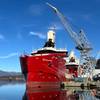National/Naval Ice Center Celebrates 30 Years of Interagency Cooperation
On Feb. 22, past and present staff members and leaders from the three participating agencies will gather to celebrate this unique collaboration. Scheduled attendees include retired Vice Adm. Conrad Lautenbacher, NOAA Administrator; Mary Kicza, Assistant Administrator for NOAA Satellite and Information Service; Rear Adm. Fred Byus, Oceanographer of the Navy; Rear Adm. Timothy McGee, Commander, Naval Meteorology and Oceanography Command; and Rear Adm. Craig Bone, the Coast Guard's Assistant Commandant for Prevention.
“The NIC is much more than a partnership. It is a truly integrated activity whose products meet the requirements of several U.S. government agencies,” said Navy Cmdr. Cory Springer, director of the NIC. A common set of analyses are used to meet operational, climatic and research requirements. To perform these services, NIC uses, in addition to other environmental data, numerous sources of satellite imagery to monitor lakes and oceans for sea ice extent, coverage, thickness and calving icebergs and ice sheets.
According to Springer, 85 percent of NIC products directly support multiple agencies. For example, NIC Bering Sea ice products support naval operations, the NOAA goal of supporting safe and efficient navigation and USCG icebreaking operations. Other users of the NIC’s products include the Navy submarine forces, National Weather Service, USCG icebreakers, Military Sealift Command units used for re-supply missions to McMurdo Station in Antarctica and Thule Air Base in Greenland, National Science Foundation research vessels and the climate change and monitoring communities. Strategic products directly support tactical Naval operations as well as helping to meet climate research requirements.
Springer said a recent review of the center’s operations indicates the tri-agency partnership eliminates redundancies and duplication in the production and delivery of operational sea ice services and provides value to each agency and its users and stakeholders. The close association between the U.S. Navy and NOAA began in 1956 with the collocation of U.S. Fleet Weather Central and the National Weather Bureau in Suitland, Md. In December 1976, a formal memorandum of agreement created the Navy/NOAA Joint Ice Center. Almost 20 years later, the U.S. Coast Guard became a partner with the Navy/NOAA Joint Ice Center, which was renamed the National Ice Center in 1995. The governing agreement for the NIC is detailed in a Navy–NOAA Memorandum of Agreement (MOA), most recently updated in July 2005. This MOA defines NIC policy, management structure, agency responsibilities and details manning and individual agency financial contributions. Source: Navnews















